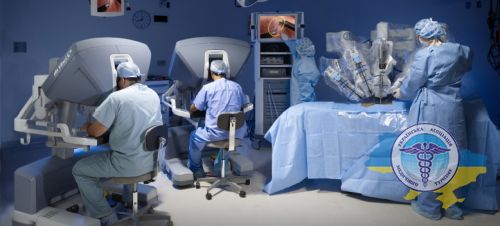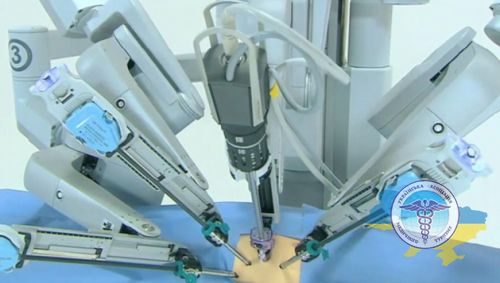Surgery by Da Vinci Robot
The Da Vinci Robot is an innovative surgical complex developed by experts at the NASA Research Center. The first unit of the device is the workplace of the surgeon, the second is the console, consisting of three manipulators equipped with a surgical instrument and one equipped with an endoscope.
Operations using the Da Vinci robot are highly accurate, safe and relatively painless (compared with abdominal operations performed in the classical way).
The Benefits of Surgery with Da Vinci Robot

The main advantages of Da Vinci robot operations compared to traditional surgery and other minimally invasive methods are:
- Security - the computer included in the complex allows eliminating any inaccuracy of manipulations and compensating for the effect of "hand shake". Due to which, the surgical intervention will be carried out with the greatest possible accuracy and accuracy;
- High accuracy - the built-in diagnostic equipment allows you to scale the surgical field, so that the surgeon is able to carry out with high accuracy even the most complex operations;
- Short rehabilitation period - the use of a robot surgeon can reduce the recovery period to one week. For comparison, after simple open operations, rehabilitation can be delayed for a period of three weeks to two months;
- Lack of need for long inpatient treatment - due to the short rehabilitation period and low trauma, there is no need to place the patient in a hospital for a long period;
- Ergonomics - the device is equipped with surgical instruments with a wider variety of motion options than the surgeon's own hand;
- Minimally invasive - the high accuracy of the surgical intervention and the absence of the “human factor” characteristic of traditional surgery provides the ability to conduct surgery through a small incision;
- The absence of serious blood loss and significant postoperative pain - a computer simulation of the surgeon's actions allows the operation to be performed without damaging large vessels and soft tissues.
What diseases are treated by a robot surgeon?

The Da Vinci surgical robot is successfully used in:
- Surgery - a robot surgeon is used to perform operations on the organs of the abdominal cavity and pelvis;
- Urology - in this area, the complex is successfully used for surgical treatment of the kidneys, bladder, and also the male reproductive system;
- Gynecology - used in operations on the uterus, ovaries and endometrial tissues;
- Endocrinology - used to minimize damage during operations on the endocrine glands;
- Otolaryngology - used in the treatment of cancer of the oral cavity, curvature of the nasal septum, etc .;
- Cardiac surgery - used for interventions on the heart and blood vessels;
- Plastic surgery - used for reconstructive plastic surgery.
How does the Da Vinci medical robot work?
Operations performed using the Da Vinci device are performed remotely without direct contact of the surgeon with the patient’s body.
For interventions, the Da Vinci medical robot is equipped with three high-tech consoles:
- Monitoring and control - the workplace of the surgeon, from which he determines the tactics of intervention, evaluates the condition of the patient and sends the appropriate commands to the robot;
- Operating room - a system consisting of three specialized manipulators, each of which is able to act both independently and in combination with the rest, which ensures the possibility of their use in almost all branches of medicine;
- Optical - during surgery, a detailed image of the surgical field and other diagnostic data are displayed on the console screen. The optical system of this console makes it possible to increase the operating field up to eight times.
The cost of the operation using the da Vinci robot
The price of an operation with a Da Vinci robot directly depends on the complexity of the surgical intervention, the prestige of the clinic and the country in which it is being performed.
Examples of the cost of treatment by a robot surgeon:
- Czech Republic - from 14 thousand dollars;
- Turkey - 16-18 thousand dollars;
- South Korea - from 16 thousand dollars;
- Germany - 20-22 thousand dollars;
- Spain - from 20 thousand dollars;
- Israel - from 25 thousand dollars.


